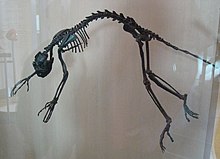

| Notharctus
| |
|---|---|

| |
| Notharctus tenebrosus | |
| Scientific classification | |
| Domain: | Eukaryota |
| Kingdom: | Animalia |
| Phylum: | Chordata |
| Class: | Mammalia |
| Order: | Primates |
| Suborder: | Strepsirrhini |
| Family: | †Notharctidae |
| Subfamily: | †Notharctinae |
| Genus: | †Notharctus Leidy, 1870 |
| Species | |
| |
| Synonyms | |
Notharctus is a genus of adapiform primate that lived in North America and Europe during the late to middle Eocene.[1]

The body form of Notharctus is similar to that of modern rats. Its fingers were elongated for clamping onto branches, including the development of a thumb. Its spine is flexible and the animal was about 40 centimetres (16 in) in length, excluding the long tail.[2]
There were at least four different Notharctus species.[1] Fossils from at least seven other potential species have also been discovered.[citation needed]

| Notharctus |
|
|---|---|